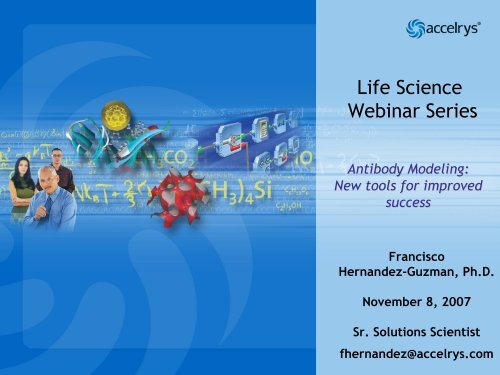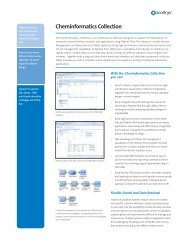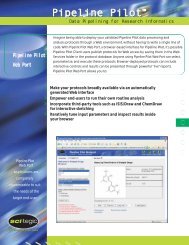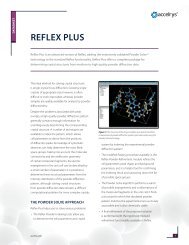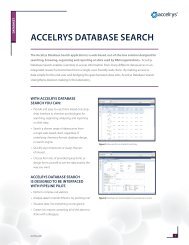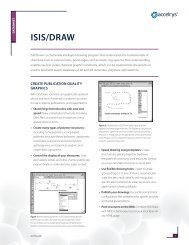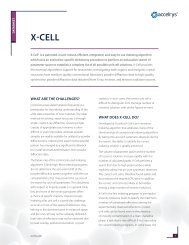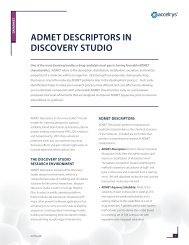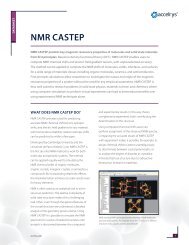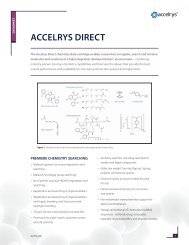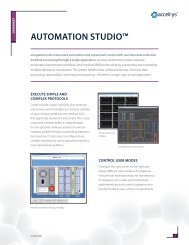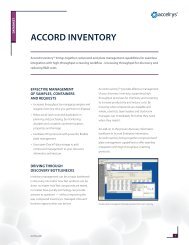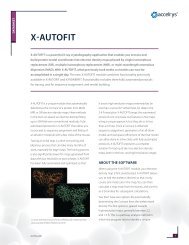of H3 loop - Accelrys
of H3 loop - Accelrys
of H3 loop - Accelrys
You also want an ePaper? Increase the reach of your titles
YUMPU automatically turns print PDFs into web optimized ePapers that Google loves.
Life Science<br />
Webinar Series<br />
Antibody Modeling:<br />
New tools for improved<br />
success<br />
Francisco<br />
Hernandez-Guzman, Ph.D.<br />
November 8, 2007<br />
Sr. Solutions Scientist<br />
fhernandez@accelrys.com
2<br />
Agenda<br />
Antibody Modeling<br />
– Why?<br />
– How?<br />
• Discovery Studio & Pipeline Pilot<br />
• Homology Modeling<br />
– Loop Refinement methods<br />
• Template based<br />
• De Novo based<br />
Conclusion
3<br />
Why Antibodies?<br />
• Critical elements <strong>of</strong> the immune system as a first line <strong>of</strong> defense against<br />
foreign entities<br />
• Wide range <strong>of</strong> uses:<br />
– Clinical: Drug therapies<br />
• In 2003 – over $2.7 billion market<br />
4<br />
The Antibody Structure<br />
• Different types <strong>of</strong> Ab but same fold Immunoglobulin<br />
• Main focus will be on IgG:<br />
Complimentary<br />
Determining<br />
Regions (CDR’s)
5<br />
The Antibody Structure (cnt’d)<br />
CDR Loops:<br />
Fab<br />
L1<br />
L2 L3<br />
CL<br />
VL<br />
H1<br />
VH<br />
H2 <strong>H3</strong><br />
Fc<br />
CH Fv
6<br />
How? Discovery Studio and Pipeline Pilot<br />
• Protocols (Calculations) can be run in Pipeline Pilot or Discovery Studio 2.0
7<br />
WebPort<br />
WebPort<br />
(web<br />
(web<br />
access)<br />
access)<br />
Pipeline Pipeline<br />
Pilot Pilot<br />
(Pro or Lite )<br />
(Pro or Lite )<br />
Chemistry Biology Materials<br />
<strong>Accelrys</strong> ® Discovery Studio<br />
ISV ISV<br />
Client Client<br />
(e.g.,<br />
(e.g.,<br />
Spotfire)<br />
Spotfire)<br />
Materials<br />
Materials<br />
Studio<br />
Studio<br />
Client<br />
Client<br />
Client Integration Layer<br />
S c i i T e g i i c P l l a t t f f o r r m<br />
Accord<br />
Accord<br />
Discovery<br />
Discovery<br />
Studio<br />
Studio<br />
Client<br />
Client<br />
Tool Integration Layer Data Access Layer<br />
Cmd-Line<br />
Statistics<br />
Reporting ISV<br />
Tools<br />
Discovery<br />
Studio<br />
Accord Accord<br />
Clients Clients<br />
IDBS Oracle ISIS<br />
Databases<br />
Isentris
8<br />
How? (cnt’d)<br />
• Procedure for Antibody Modeling:<br />
1. Sequence based search for homolog<br />
2. Sequence Alignment<br />
3. Building <strong>of</strong> Homology Model<br />
4. Analysis <strong>of</strong> Homology Model<br />
5. Identification <strong>of</strong> CDR <strong>loop</strong>s<br />
6. Refinement <strong>of</strong> the <strong>loop</strong>s<br />
– Template<br />
– de novo
9<br />
Loop Refinement Method: Template Based<br />
• Model Antibody Loops protocol<br />
– Uses BLAST to find possible templates and alignment to templates<br />
– Based on the alignment, automatically detects hyper-variable <strong>loop</strong><br />
regions<br />
– Detects the key signatures if any<br />
– Based on <strong>loop</strong> similarity and key signature, automatically selects the<br />
best templates for each <strong>loop</strong><br />
– Uses MODELER to build new model with “grafted” <strong>loop</strong> regions<br />
Input structure<br />
Option to construct<br />
homology model<br />
using MODELER
10<br />
Example: Template based refinement <strong>of</strong> Antibody<br />
hyper-variable <strong>loop</strong> regions<br />
• Modeling <strong>of</strong> the 1flr.pdb Fab fragment<br />
– Hypervariable <strong>loop</strong> detection<br />
– BLAST detected templates<br />
– Key signatures<br />
Key signatures
11<br />
Example: Template based refinement <strong>of</strong> Antibody<br />
hyper-variable <strong>loop</strong> regions<br />
• Modeling <strong>of</strong> the 1flr.pdb Fab<br />
fragment<br />
– Retrieves antibody templates<br />
– BLAST detected templates<br />
– Key signatures<br />
CDR <strong>loop</strong> Loop length C-alpha RMSD BB-RMSD<br />
L1<br />
L2<br />
L3<br />
H1<br />
H2<br />
<strong>H3</strong><br />
12 1.06 1.08<br />
3 0.54 0.50<br />
6 0.56 0.58<br />
7 0.60 0.63<br />
8 0.87 0.94<br />
7 0.55 0.57<br />
“Direct” self hit removed
12<br />
Additional Fab Examples: Template based refinement<br />
• Modeling <strong>of</strong>: 2ajs.pdb<br />
• Modeling <strong>of</strong>: 2gcy.pdb<br />
• Modeling <strong>of</strong>: 2nyy.pdb<br />
CDR <strong>loop</strong> Loop length C-alpha RMSD BB-RMSD<br />
L1<br />
L2<br />
L3<br />
H1<br />
H2<br />
<strong>H3</strong><br />
12 1.36 1.40<br />
3 0.36 0.43<br />
6 0.81 1.24<br />
8 1.30 1.62<br />
5 2.16 2.00<br />
10 4.08 3.84<br />
CDR <strong>loop</strong> Loop length C-alpha RMSD BB-RMSD<br />
L1<br />
L2<br />
L3<br />
H1<br />
H2<br />
<strong>H3</strong><br />
11 1.00 1.03<br />
3 0.91 0.87<br />
6 1.04 1.33<br />
7 0.54 0.57<br />
6 0.57 0.53<br />
9 1.67 1.92<br />
CDR <strong>loop</strong> Loop length C-alpha RMSD BB-RMSD<br />
L1<br />
L2<br />
L3<br />
H1<br />
H2<br />
<strong>H3</strong><br />
11 0.93 0.94<br />
3 0.65 0.64<br />
6 0.57 0.63<br />
7 0.73 0.73<br />
6 0.84 0.82<br />
9 2.64 2.68
13<br />
Summary:<br />
• The “Model Antibody Loops” protocol successfully automates the<br />
tedious task <strong>of</strong> antibody <strong>loop</strong> grafting<br />
• Automated hyper-variable <strong>loop</strong> detection helps to quickly identify<br />
the <strong>loop</strong>s <strong>of</strong> interest<br />
• Model building is incorporated seamlessly to the process using<br />
MODELER
14<br />
Loop Refinement Method: de novo<br />
• Full <strong>loop</strong> reconstruction without prior knowledge<br />
• Use <strong>of</strong> CHIROTOR and LOOPER algorithms<br />
– CHIROTOR<br />
• CHARMm based algorithm<br />
• Automatically rebuild side chains de novo<br />
– LOOPER<br />
• CHARMm based algorithm<br />
• Automatically reconstruct <strong>loop</strong> regions de novo
15<br />
Side-Chain Refinement using ChiRotor<br />
• ChiRotor side-chain<br />
refinement:<br />
– Performs systematic<br />
search side-chain<br />
conformations<br />
– Minimizes<br />
conformations using<br />
CHARMm<br />
– Selects the best<br />
conformation based on<br />
CHARMm energy<br />
• Fast abintioapproach<br />
not dependent on the<br />
starting structure<br />
– Rebuilds the sidechains<br />
Animated figure
16<br />
ChiRotor<br />
Methodology<br />
Protein<br />
3D Structure<br />
Select a Set <strong>of</strong> n<br />
Residues<br />
For Refinement<br />
Remove all side<br />
chain atoms <strong>of</strong><br />
selected residues<br />
Start <strong>loop</strong> for i from 1 to n<br />
Choose Residue i<br />
Sample side chain<br />
conformations <strong>of</strong><br />
residue i varying χ 1<br />
Energy Minimize side<br />
chain atoms <strong>of</strong> residue<br />
i in CHARMm<br />
Save 2 Best<br />
Conformations for<br />
residue i<br />
End <strong>loop</strong> for i<br />
Output: 2n partial<br />
structures<br />
Construct complete<br />
structure using lowest<br />
energy conformer <strong>of</strong> each<br />
residue.<br />
Energy minimize all<br />
selected side chains<br />
Start <strong>loop</strong> for i from 1 to n<br />
Replace side chain<br />
conformation i with the 2 nd<br />
conformer and energy<br />
minimize<br />
Accept the structure if energy<br />
is lower.<br />
End <strong>loop</strong> for i<br />
Output: 1 Lowest Energy<br />
structure
17<br />
Loop Refinement using Looper<br />
• The Looper <strong>loop</strong><br />
refinement algorithm<br />
– Systematically<br />
searches for backbone<br />
conformation<br />
– Uses CHARMm<br />
minimization<br />
– Ranks the<br />
conformation using<br />
CHARMm energy,<br />
including solvation<br />
energy term<br />
• Fast, ab intio approach<br />
not dependent on the<br />
starting structure<br />
– Rebuilds the <strong>loop</strong><br />
Loop Refinement protocol and results in Discovery Studio
18<br />
Looper Methodology<br />
• Looper first constructs and optimizes the <strong>loop</strong><br />
backbone<br />
– Systematic search <strong>of</strong> <strong>loop</strong> conformation by<br />
sampling a minimum set <strong>of</strong> backbone dihedral<br />
angles φ and ψ<br />
– The <strong>loop</strong> is divided into two halves and each half<br />
is constructed independently from the end <strong>of</strong> the<br />
<strong>loop</strong> and then combined without the side-chain<br />
atoms<br />
– The <strong>loop</strong>s are minimized by CHARMm and ranked<br />
by CHARMm energy<br />
Continued…
19<br />
Looper Methodology<br />
• Next, Looper constructs the <strong>loop</strong> side chains<br />
and optimizes the <strong>loop</strong><br />
– Construct the side-chains using the ChiRotor<br />
and the <strong>loop</strong> conformations are ranked by<br />
CHARMm energies<br />
• Finally, Looper re-ranks the conformations<br />
– CHARMm energy minimizations in the first two<br />
steps are done without including the solvation<br />
energy term<br />
– In this step, each top ranking <strong>loop</strong><br />
conformation is re-scored by adding the<br />
solvation energy term calculated using<br />
Generalized Born approximation (in CHARMm)
20<br />
Example: Homology Modeling <strong>of</strong> an Antibody fragment and<br />
de novo reconstruction <strong>of</strong> <strong>H3</strong> <strong>loop</strong><br />
• Modeling <strong>of</strong> the 2aab Fab fragment<br />
– Clinically relevant melanoma antigen system<br />
– 25 models built, high quality<br />
– 1mf2 used as template<br />
– 89.4% id, 92.8% sim<br />
8 residue <strong>H3</strong> <strong>loop</strong> modeled!!!<br />
Fab<br />
RMSD* (seq): 2.46, 434 residues<br />
RMSD* (struct): 1.94 279 residues<br />
Fv<br />
RSMD* (seq): 1.27, 232 residues |0.90 224 residues * †<br />
RMSD* (struct): 0.83, 224 residues | 0.76, 220 residues* †<br />
* backbone atom rmsd † no <strong>H3</strong> <strong>loop</strong> included
21<br />
MODELER<br />
• Best Homology model:<br />
Fv RMSD (seq) Fv RMSD (seq) MODELER<br />
1.27 (232 resid)<br />
Green = 2aab cryst.<br />
Red = 1mf2 cryst.<br />
Orange = 2aab H. Mod.<br />
0.90 (224 resid)<br />
<strong>H3</strong> <strong>loop</strong> not incl.<br />
Fv RMSD (seq)<br />
1.18 (232 resid)<br />
MODELER<br />
Fv RMSD (seq)<br />
0.90 (224 resid)<br />
<strong>H3</strong> <strong>loop</strong> not incl.<br />
<strong>H3</strong> <strong>loop</strong> RMSD<br />
4.11 (8 resid)
22<br />
Loop refinement<br />
Mutate <strong>H3</strong>-<strong>loop</strong> to Ala<br />
Side Chain refinement <strong>of</strong> residues within<br />
8Å radius (ChiRotor*)<br />
Mutate <strong>H3</strong>-<strong>loop</strong> residues back<br />
Loop Refinement (LOOPER**) <strong>of</strong> <strong>H3</strong> <strong>loop</strong><br />
Case:<br />
Pre-Ref.<br />
bb RMSD<br />
Post-Ref.<br />
bb RMSD<br />
No Neighbor<br />
opt.<br />
4.11Å<br />
3.81Å sol #1<br />
3.02Å sol#3<br />
Neighbor opt.<br />
4.11Å<br />
1.79Å sol #1 (3)<br />
1.54Å sol #21 (25)<br />
*Spassov, V. et al. Protein Science. 16:1-13 2007<br />
** Spassov, V. et al. (manuscript)<br />
2aab crystal<br />
struct.<br />
1.30Å<br />
X-ray structure<br />
post-refined<br />
pre-refined<br />
side view<br />
top view
23<br />
Summary:<br />
• Success <strong>of</strong> LOOPER strongly correlated to proper positioning <strong>of</strong><br />
neighboring side-chains around the <strong>loop</strong><br />
• ChiRotor successfully refined neighboring side chains for better <strong>loop</strong><br />
refinement<br />
• Need to generalize our method with more test cases
24<br />
Conclusion<br />
• Rules based recognition <strong>of</strong> hyper-variable <strong>loop</strong> regions can be used to<br />
quickly annotate and properly align sequences for template based<br />
modeling<br />
• Template based methods can model hyper-variable <strong>loop</strong> regions with good<br />
accuracy<br />
• De novo <strong>loop</strong> refinement methods are not bound by template bias and<br />
also show a high degree <strong>of</strong> success for rebuilding the highly flexible<br />
hyper-variable <strong>loop</strong>s such as the <strong>H3</strong> <strong>loop</strong> <strong>of</strong> the 2aab antibody fragment<br />
• Success in our de novo <strong>loop</strong> reconstruction calculation was directly<br />
correlated with the proper positioning <strong>of</strong> the neighboring side chains<br />
• Two methods represent the full solution for Antibody <strong>loop</strong> modeling
25<br />
Acknowledgements<br />
• Velin Spassov<br />
• Zeljko Dzakula<br />
• Yi-Shiou Chen<br />
• Lisa Yan<br />
• Paul Flook<br />
• Shikha Varma-O’Brien
26<br />
References:<br />
• Brooks, B. R.; Bruccoleri, R. E.; Olafson, B. D.; States, D. J.;<br />
Swaminathan, S.; Karplus, M. CHARMM: A program for<br />
macromolecular energy minimization and dynamics calculations.<br />
1983, J. Comp. Chem. 4: 187-217<br />
• Morea V., Lesk A. and Tramontano A. Antibody Modeling:<br />
Implications for Engineering and Design. 2000, METHODS 20: 269 –<br />
279<br />
• Sali A. & Blundell T.L. Comparative protein modelling by<br />
satisfaction <strong>of</strong> spatial restraints. 1993, J. Mol. Biol. 234: 779-815<br />
• Spassov V., et al. The dominant role <strong>of</strong> side-chain backbone<br />
interactions in structural realization <strong>of</strong> amino acid code. ChiRotor:<br />
A side-chain prediction algorithm based on side-chain backbone<br />
interations. 2007, Protein Science. 16: 494-506


